Japanese Continued to Learn From the West
- Early Japan until 710
- Nara Period 710-794
- Heian Period 794-1192
- Kamakura Period 1192-1336
- Muromachi Period 1336-1573
- Azuchi-Momoyama Period 1573-1603
- Edo Period 1603-1868
- Meiji Period 1868-1912
- Taisho and Early Showa Period 1912-1945
- Postwar Period 1945-Present
Japan & Early Westernization: A Study of the Extent of Westernization in Japan by 1900
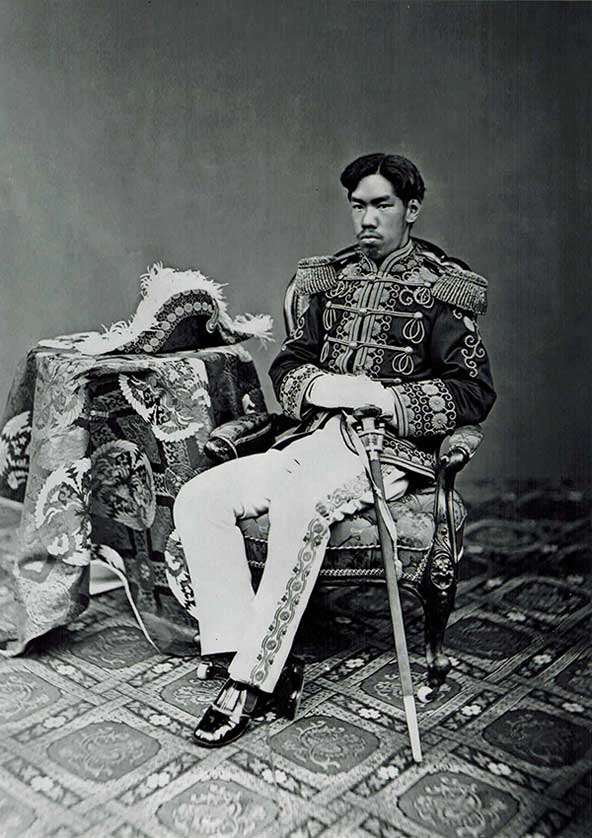
The Emperor Meiji 1852-1912
Philip Beech
- Clothing Food and Housing
- Education
- The Press, the Arts and Sport
- Urbanization & Industrialization
- The Military
- The Law
- Sources
That Japan changed more in the four and a half decades to 1900 since the arrival of Commodore Perry in Shimoda in 1853 than in the three centuries of Tokugawa control is beyond question.
Folklorist Kunio Yanagida sees this change as "virtually revolutionary." One oft quoted contemporary observer, Basil Hall Chamberlain, captures the depth of these changes. "To have lived through the transition stage of modern Japan makes a man feel preternaturally old; for here he is in modern times.... and yet he can himself distinctly remember the Middle Ages."
However, by the end of the nineteenth century as the nation became more confident, voices were raised concerning whether Japan had gone too far in its policy of bunmei kaika and imitation of the West.
The Tokugawa regime attempted to hermetically seal Japan to the outside world to prevent change, the Meiji leaders strove to execute change. The pressure and motivation for this change was the Western threat to Japan's sovereignty itself and the need to reverse the unequal treaties imposed on Japan in the 1850's.
Thus, under the slogans of fukoku kyohei (Enrich the country, strengthen the military) and bunmeikaika (Civilization and Enlightenment), the Meiji leadership attempted to industrialize the nation and strengthen the army to protect national independence.
Later the movement for civilization and enlightenment, adopted by government and intelligentsia, hoped to impress on the West that Japan was now an equal partner in world affairs and so could set its own tariffs and administer its own laws to Japanese and foreigners alike.
The new Meiji government, officially and privately sponsored missions abroad such as the Iwakura Mission of 1872-1873 when Iwakura Tomomi, Ito Hirobumi and Kido Koin traveled to the USA and Europe with some 40 other Japanese government officials and around 60 students.
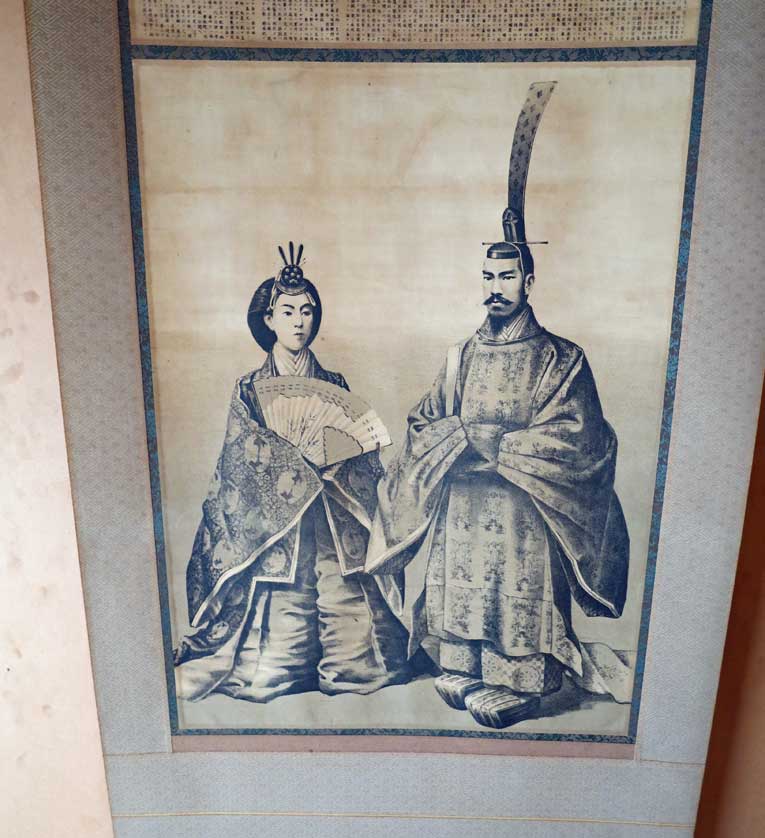
The Emperor Meiji 1852-1912 and Empress Shoken
Translations of western books and the presence in Japan of foreign teachers were all agents for change in the second half of the nineteenth century. Some 3,000 foreign teachers and technicians were invited to Japan between 1868-1890 among them David Murray of Rutgers, who helped establish the new elementary school system and Ludwig Riess (1861-1928), who established a school of historical studies at Tokyo University.
We survey the "modernization" and change that took place in Japanese society up to 1900 by looking at various aspects of that society.
Clothing, food and housing (i-shoku-ju)
The government and through it, the army, were the first to make changes to clothing in Japanese society. A regulation of 1872 ordered the substitution of Western dress for the ceremonial robes of court nobles, and even the Emperor had appeared in Western dress in 1870.
The army had begun to wear Western uniforms since the bakumatsu period. However basic clothing did not change significantly for most Japanese during the second half of the nineteenth century due to high costs and suitability to other aspects of Japanese living, for example, sitting on the floor and the custom of removing shoes before entering a house made the high-button styles of this period rather impractical.
More noticeable were the changes in hairstyles with the short cut replacing the topknot, so that by 1890 it was difficult to find a man in the cities with a traditional hair style. For women, blackened teeth and shaved eyebrows began to disappear quickly from the cities and more slowly in the countryside.
After men cut their hair, they began to wear Western style hats and carry umbrellas and pocket watches. Imported wool began to be used for coats and shawls but these were generally worn over the kimono and were expensive and therefore limited to the prosperous few. Indeed, Western clothing often seems to have been used as an accessory. It appears officials would usually don traditional clothing in the home after wearing Western attire to work.
The major changes that occurred in Japanese housing in the period seem to have be "a diffusion of innovations from the Tokugawa period" including the adoption of shoji (paper-on-wooden-frame room dividers), engawa (the balcony) and fusuma (sliding wall-style panels) from samurai houses by the growing number of salaried workers and farmers where they could afford to do so.
Thus wood replaced dirt and tatami replaced wood. These were Japanese innovations rather than "modern", Western ones. However, kerosene and oil lamps tended to replace rapeseed lamps in the Meiji Period and this added to the increased use of shoji and sometimes glass and new, hard, ceramic hibachi led to the family not having to be centered around the stove as the only source of heat and light. A corollary of increased light was that Japanese houses began to become cleaner and more sanitary.
It was in Tokyo and the larger cities that new, Western style concrete, stone and brick buildings and bridges were built. These were often designed by foreign architects and the most famous include The Bank of Japan, Ginza Bricktown, The Asakusa Twelve Storeys, Tokyo Central Station, Shimbashi Station and the infamous Rokumeikan Dance Hall. Gas lighting came to the Ginza in 1874 and electricity in 1878. However, it was not until well into the twentieth century that Tokyo began to resemble London, Paris or New York rather than old wooden Edo.
As for eating habits, the Meiji period saw a wider diffusion of changes begun in Tokugawa times with increases in the consumption of polished rice, tea, fruit, sugar and soy sauce. Dining out also became more widespread. With the development of communications and increased social mobility, local customs such as eating seafood became national ones over time. Meat eating though encouraged by such "modernizers" as Fukuzawa Yukichi and spread through conscription (along with beer) did not become widespread in Japan until after World War II.
Beer was first brewed in Japan in the 1870s initially by foreigners in Yokohama, an operation that was later sold to Japanese entrepreneurs and was to become Kirin Beer. In Sapporo, in Hokkaido, beer was produced in 1876 by a company that was to become the modern day Sapporo Beer. The first beer hall was opened by Sapporo Beer in Ginza in Tokyo in 1899.
Conservative commentators of the time reveal the influx of new western fashions and the greater spread of samurai customs to the general populace:
Everyone has forgotten the righteous way. Now everyone is working for profit.... In the villagers we now have hairdressers and public baths. If you see houses you see flutes, shamisen and drums on display. Those living in rented houses, the landless and even servants have haori, umbrellas, tabi and clogs. When you see people on their way to the temple, they seem better dressed than their superiors.
Education
An area of greater change and modernization was in the field of education, though the changes owed more to Western ideals than actual practice. After the creation of the Mombusho in 1871 the Fundamental Code of Education in 1872 provided the design for a nationally unified government controlled system to provide for elementary and middle schools and universities. Compulsory attendance for all regardless of gender and previous class distinctions was set at four years. This did not become a reality until 1900, however, when education was made free.
The early emphasis of Meiji Period education was utilitarian, with knowledge seen as the capital for self-improvement and raising the individual. From the 1880's onwards, the Mombusho under Mori Arinori began to change education to a more nativist position to serve the interests of the nation.
Thus in the 1890 Rescript on Education, teachers became servants of the state, traditional values of loyalty and filial piety were stressed along with devotion to the Emperor and the nation. The Mombusho determined curricula, selected textbooks, prepared examinations, increased the emphasis on morals and decided teaching methods so that, "The school system became an effective instrument of national policy."
At the tertiary level, Tokyo University was created out of an amalgam of three shogunal schools in 1877, and Kyoto University was founded in 1897. Private universities including Fukuzawa's Keio, Shigenobu Okuma's Waseda and Niishima Jo's Christian Doshisha were also founded around this time. Hokkaido University grew out of the Sapporo Agricultural College and the influence of its first foreign vice-president William Clark, brought over from Amherst.
All these schools employed foreign teachers and were extremely westernized and through the increase of the teaching of law, which became a route into government service, Japan gradually became a more meritocratic society.
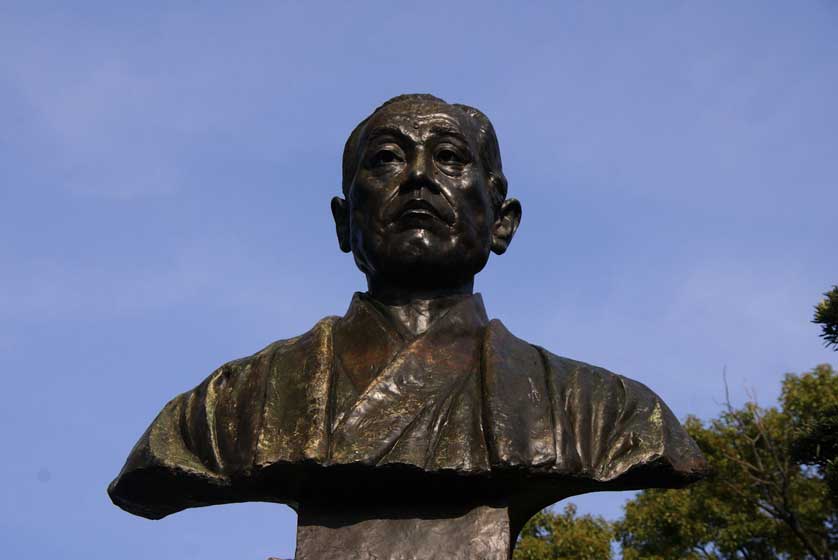
Bust of Fukuzawa Yukichi, Meiji Modernizer & the Face on the 10,000 Yen Banknote
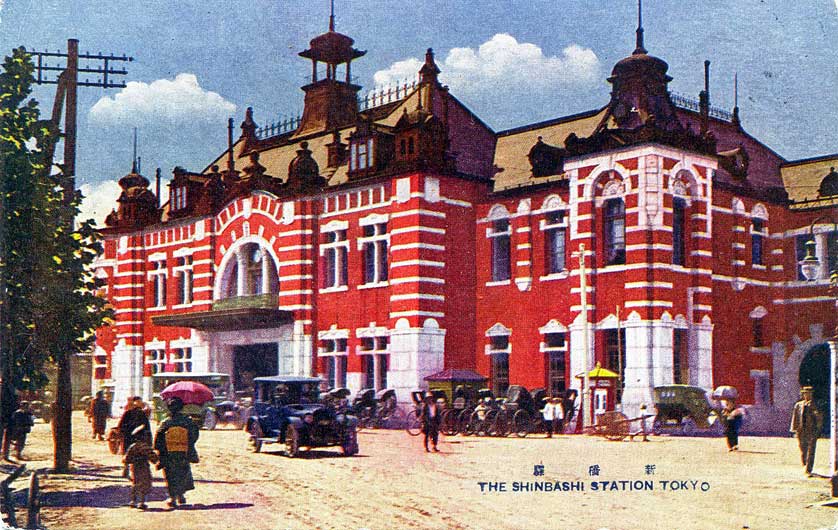
Shimbashi Station Tokyo in the Taisho Period
The Press, the Arts and Sport
Another area of change and modernization was the press which grew out of western initiatives in the treaty ports. Its development was greatly speeded by the modern printing press which replaced wood block printing. Western knowledge and literature was disseminated through a growing range of translations, books and newspaper and magazine articles.
Fukuzawa's Seiyo Jijo detailing Western ships, banks and parliaments became a best seller along with Nakamura Keiu's translations of Samuel Smiles' Self Help and J.S. Mill's On Liberty. Meiroku Zasshi was an influential journal including contributions from Japan's leading commentators on the West, including Nishi Amane, Mori Arinori and Tsuda Mamichi.
By 1890, there were 716 newspapers in print in Japan with a circulation over 500,000. Among them were theTokyo nichi-nichi shimbunwhich published the first Japanese daily editorial and the Yomiuri shimbun, which used furigana to reach out to a popular base.
In literature, authors, such as Natsume Soseki (1867-1916), adopted a more straightforward modern prose and discovered a new interest in the individual, though Meiji writers were not totally reliant on Western conventions and techniques.
Oil painting was introduced to Japan in the Meiji Period and practiced by Kawakami Togai and Takahashi Yuichi, ironically at a time when Western appreciation of traditional art was very high. For example, Van Gogh had organized an exhibition of Japanese prints in Arles, which he referred to as "his Japan." Western church, military and public school music also merged with the traditional legacies to create a modern but discernibly Japanese style.
New Western sports made their appearance in Japan for the first time, including baseball, cricket, football, athletics and rowing at such new foreign institutions as the Kobe Regatta and Athletic Club established in 1870 and the Yokohama Country & Athletic Club founded in 1868.
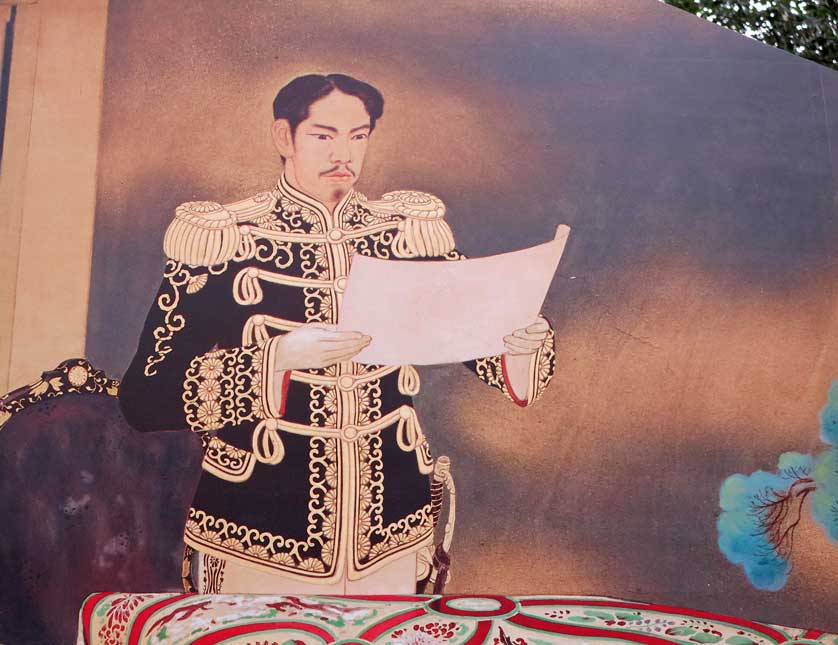
The Emperor Meiji in Western Military Attire
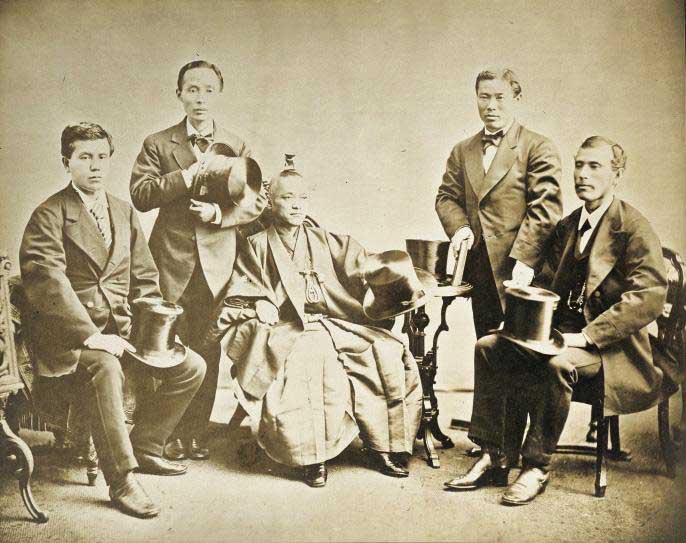
Members of the Iwakura Mission to the USA & Europe; Iwakura Tomomi seated in Japanese dress
Urbanization, industrialization and communications
The 1873 Land Tax Revision had a great influence on the modernization of Japanese society. After the abolition of the han and the shi-no-ko-sho class divisions, the new Japanese government turned its attention to creating a centralized, efficient tax system to finance its programme of fukoku kyohei.
This resulted in a 3% tax on the saleable value of land. Payment, in cash, shifted from the producer to the owner and thus "the cultivator was thrust from a position of comparative self-sufficiency to dependence on the market."
Another change that effected Japanese society was that the land became private property and therefore alienable. Also, lands which had previously been held in common (often for timber and thatch) became taxable and began to be taken over by village headmen and the richer farmers.
Agricultural productivity increased, but land was concentrated in fewer hands, as poor cultivators were forced to sell their land and become tenants. As the economic gap between owner and tenant widened, younger sons and daughters often migrated to the town to find work in new industries, or as maids, coolies and rickshaw pullers. Home production of commodities declined due to the loss of common land but industrial production increased which, in turn, fed migration to the cities and Japanese emigration overseas to Hawaii and South America.
The Meiji government directly stimulated and invested the revenues from the land tax and the duties on the export of silk and tea in industry as part of its policy of "enriching the nation".
Meiji authorities proclaimed a freedom in commerce which abolished the guilds' monopolies and allowed the samurai to engage in trade. The conversion of samurai stipends to bonds gave them some capital to do so. The formation of joint stock companies and the idea of limited liability were new to Japan at this time.
The state invested in seri-culture by importing Western filatures and after the founding of the Osaka Cotton Spinning Company in 1882 by Shibusawa Eiichi, textile manufacture expanded dramatically so that by 1900 exports exceeded imports. The government also subsidized infrastructure by investing in railways, shipping, telegraphs, ports, lighthouses and by encouraging the creation of banks, post offices for mail and savings and Chambers of Commerce.
However, it was not until the last decade of the nineteenth century and the period up to the end of World War I that Japanese industry, and in particular heavy industry, really took off. In 1900, Japan was still essentially an agrarian nation and in 1910 there were still only 300,000 male industrial workers and raw silk accounted for just under 40% of total export earnings. Also, not until 1911, was over 50% of both import and export trade in the hands of Japanese companies.
The Military
Even though in terms of numbers the armed forces were not a large proportion of Japanese society (they numbered around 41,000 in 1878 and 73,000 in 1883 building to a war time strength of around 200,000 , their modernizing impact and influence on other sectors such as education, health and industry were great.
The military was the first to modernize in terms of dress, technology and the hiring of foreign advisors. Conscription and military life were completely foreign to new soldiers. Shoes, trousers, beds, tinned food, bread, beer and cigarettes gradually permeated into society at large. The mixing of recruits from different areas and the rigidity of army life led to the breakdown of many village taboos and customs .
Ex-military men often moved into the Police and education influencing those sectors. The navy spurred the development of heavy industry through the Yokosuka and Tsukiji dockyards as Japan's navy increasingly began to be manufactured, not bought from Britain.
The building of the nationwide telegraph system also owed much to military needs as did the development of modern accounting and the growth of "organizational professionalism" - training, certification, conferences and a specialized literature - which spread into the private business sector.
The Law
The law along with the Land Tax Revision was a major contributor to the modernization of Japanese society. From the Meiji Restoration to 1900, a national as opposed to a local legal system was adopted. The driving force behind the changes was to win foreign approval of both the code and the administrative machinery to end extraterritoriality in the law as applied to foreigners under the treaties with the Western Powers.
In 1882, a criminal code largely inspired by the Napoleonic model and drawn up under a French advisor, Gustave Emile Boissonade (1825-1910), was issued. This ended torture and introduced public trials (though these could be suspended by government order). A commercial code under German influence was fully adopted in 1899.
In 1898, a civil code finally emerged after much debate which confirmed individual property ownership and individual rights - kenri- (a new concept in Japan) over feudal obligations.
However traditional, nativist pressure and German absolutist legal theories saw that the new code fitted to conservative practices. Thus "laws were incorporated safeguarding such vital aspects of the family as filial piety, primogeniture, and even the greater subservience of the wife to the husband."
The 1889 Constitution also guaranteed certain basic rights but these could be rescinded by government legislative action.
By 1900, times had changed, quite literally with the adoption of the Gregorian calendar. The very word for society - shakai - was a new compound. This society, too, had become more complicated so that "Japan in 1865 bore small resemblance to the Japan of 1890."
The structural aspects that characterize modernity, a Constitution, a modern army, mass education and what Hobsbawn sees as "that comparatively recent historical innovation, the nation with its associated phenomena: nationalism, the nation state, national symbols and histories" were all in place.
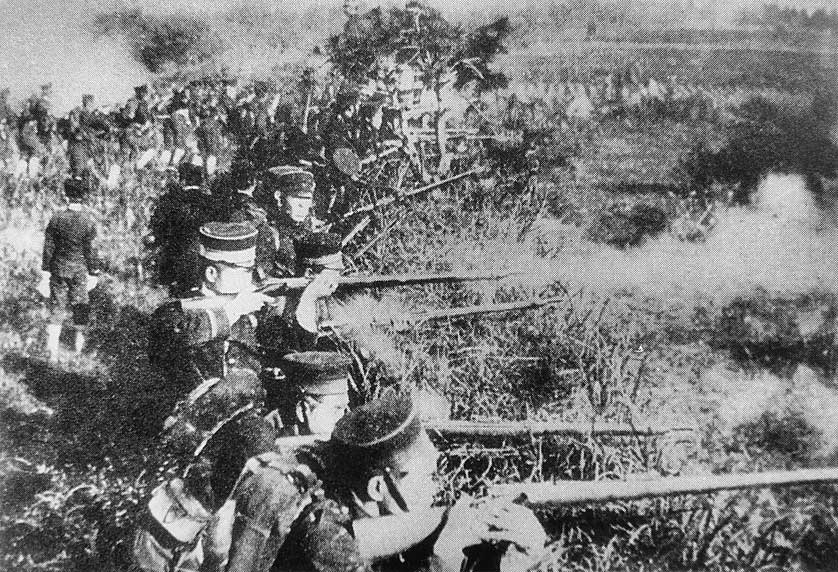
Japanese troops in action during the Sino-Japanese War 1894-1895
Japan had fought a successful foreign war against China in Korea (1894-5) and the unequal treaties had been revoked by 1899. Thus, politically and institutionally Japan was much changed since the Meiji Isshin.
The Japanese historians Yamagida and Irokawa chart the changes in popular consciousness as people were both inspired and forced to change their way of life. The ancient feeling of belonging to a specific village and a particularie, though still apparent today, began to give way as Japanese society was influenced by urbanization, capitalism and individualism.
People began to migrate to the towns and cities, even to Hawaii and America. Women slowly began to find jobs not just in silk factories but as telephone operators, in the new department stores and as teachers and doctors.
Though Yanagida sees women losing some of the rights they held in the pre-modern era, such as the consent of the bride in marriage. Young boys in the pages of Eisai Shinshi wrote of their modern desire to "get on in the world." Irokawa quotes a poem by the monk Gessho with the line "How can the village graveyard be the only resting place" to illustrate a fundamental shift in thought.
By 1900, more and more children had begun to receive elementary school education and more young men were serving in the Japanese army or the reservist associations. The impact of new, western ideas of individual rights and freedoms were not confined to the western travelled intelligentsia alone as the People's Rights movement and Irokawa's discovery of a People's Constitution has shown. The formation of the Edo Association in 1899 to preserve Edo culture reveals how much some people thought the nation was changing and the old ways of a bygone age needed to be preserved.
Indeed, it is the change in the 1890s from the creation of the institutions of a modern society to a newfound ability to comment on the changes that these institutions and new ways of thinking had on society - shakai mondai - that mark an awareness of the "modern age "among the government, its ideologues and the people themselves."
Gluck sees the ideology of a nation state and a "society" to be controlled and shaped as symbolic of modernity. The state ideology expanded its target from the old feudal aristocracy to include everyone. Although most of this ideological debate really got going in the years just after 1900 , the moral comment on such perceived modern maladies as "get rich quick fever" and "money worship" reveals the complicated and modern nature of Japanese society by the turn of the century.
Japan had changed much since the opening of the country by the foreign powers. Some of these changes had seen traditional practices become more widespread as in the case of food, dress and housing. Completely modern changes had occurred in transportation, law and communications. Japan also regressed in certain areas, as in the case of a woman's possibility to choose a spouse.
Overall, however, the main aspects and institutions of a modern nation were in place in Japan by 1900. Japan had a Constitution, a law code, a centralized bureaucracy, schools, an army, a thriving press, a system of local government.
Modern trends had begun which were to continue throughout the next century, such as urbanization, capitalist industrialization and labor organization. Intellectuals argued about how good westernization was for this new concept of "society" and a move for the "preservation of the national essence" and the slogan wakonyo sai (Japanese spirit and Western techniques) became prominent. By 1900, the transition to a modern state and a mass society in Japan could be said to have truly begun.
Sources & Books on Japanese History
Beasley, W. G. (1990). The Rise of Modern Japan. London: Weidenfield & Nicholson.
Chamberlain, B. H. (1891). Things Japanese.
Gluck, C. (1985). Japan's Modern Myths. Princeton: Princeton University Press.
Hanley, S. (1986). The Material Culture: Stability in Transition. In M. B. Jansen, & G. Rozman (Eds.), Japan in Transition from Tokugawa to Meiji (p. 157). Princeton: Princeton University Press.
Hobsbawn, E. (1983). The Invention of Tradition. Cambridge: Cambridge University Press.
Jansen, M. B. (1989). The Cambridge History of Japan (Vol. 5 (Japan in the Early Nineteenth Century)). Cambridge: Cambridge University Press.
Lehman, J. P. (1982). The Roots of Modern Japan. MacMillan.
Norman, E. H. (1940). Japan's Emergence as a Modern State. Institute of Pacific Relations.
Rubinger, R. (1986). Education: From One Room to One System. In M. B. Janzen, & G. Rozman (Eds.), Japan in Transition from Tokugawa to Meiji. Princeton: Princeton University Press.
Westney, E. D. (1986). The Military. In Japan in Transition from Tokugawa to Meiji (p. 183). Princeton: Princeton University Press.
Yanagida, K. (1957). Japanese Manners & Customs in the Meiji Era. Tokyo: Obunsha.
Books on Modern Japanese History
Westernization in Japan 1868-1900: read an essay on the history of westernization and modernization in Japan from the beginning of the Meiji Period until 1900.
Source: https://www.japan-experience.com/plan-your-trip/to-know/understanding-japan/westernization
0 Response to "Japanese Continued to Learn From the West"
Post a Comment